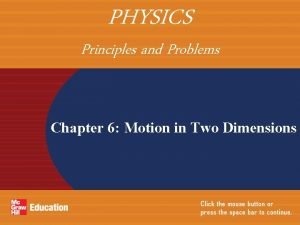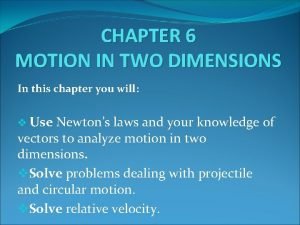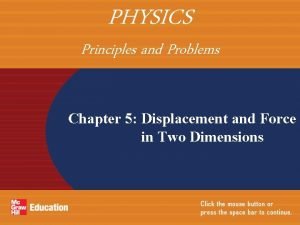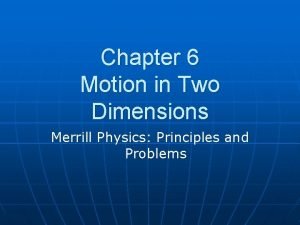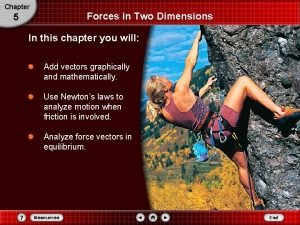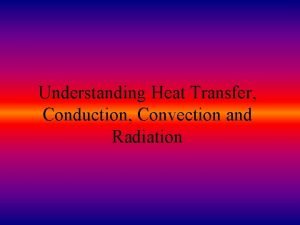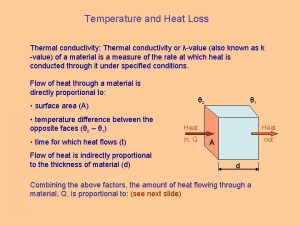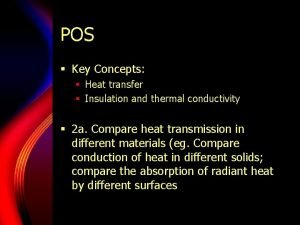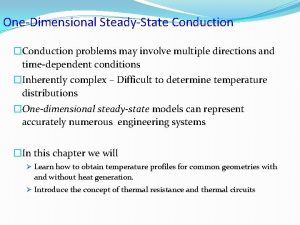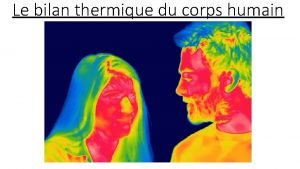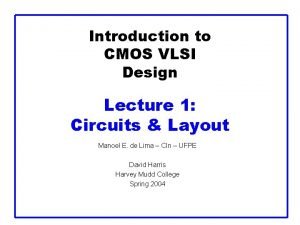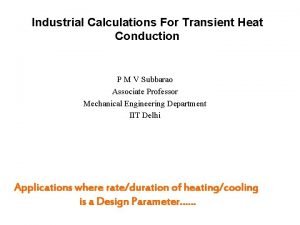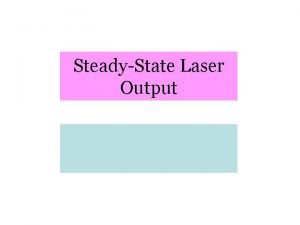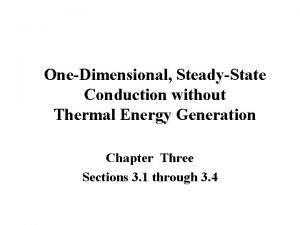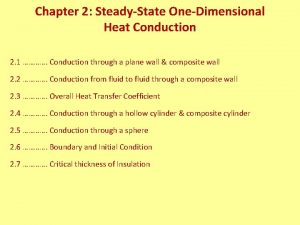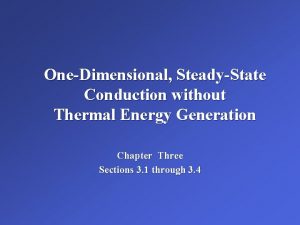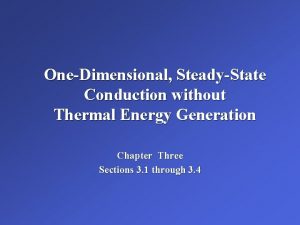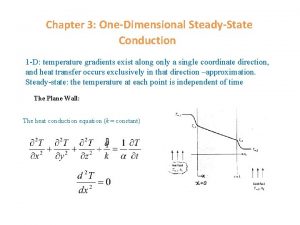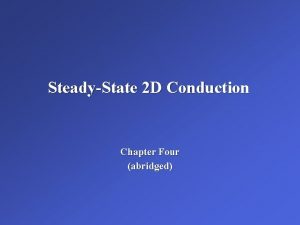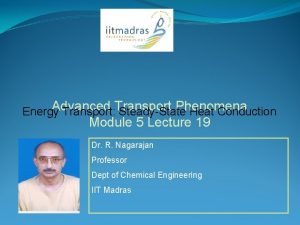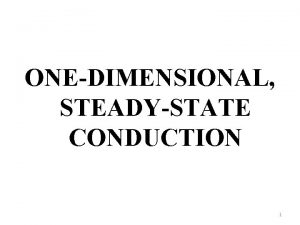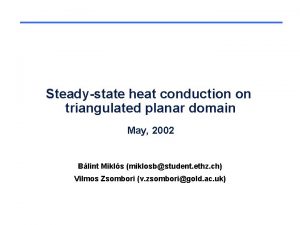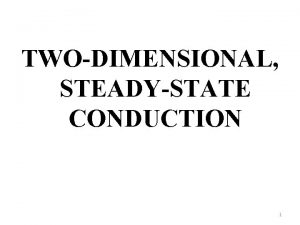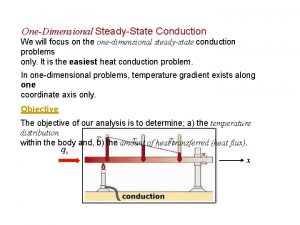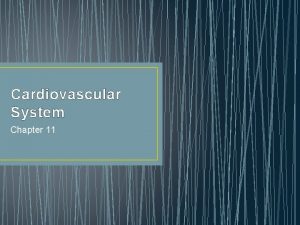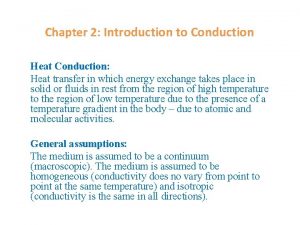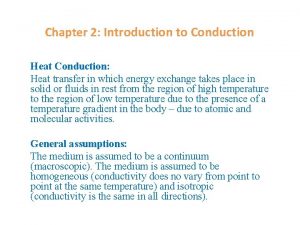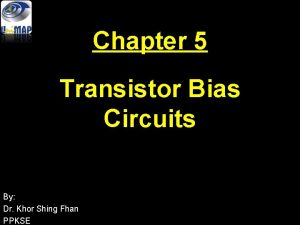CHAPTER 3 STEADYSTATE CONDUCTION MULTIPLE DIMENSIONS Dr Khor































- Slides: 31

CHAPTER 3 STEADY-STATE CONDUCTION – MULTIPLE DIMENSIONS Dr. Khor Chu Yee Office: S 4 -L 2 -64 Email: cykhor@unimap. edu. my H/P: 019 -5637283 1

2

3

4

5

k (T 1 - T 2) 6

k (T 1 - T 2) 7

8

1 3 Isothermal line 4 5 N M 9

10

Table 3 -1. q = k S (T 1 -T 2) q = (T 1 -T 2) / Rth = 1/ k S Note: Sfc = S 11

S 12

13

S 14

15

S 16

17

18

19

20

21

WHY NUMERICAL METHODS? In Chapter 2, we solved various heat conduction problems in various geometries in a systematic but highly mathematical manner by (1) deriving the governing differential equation by performing an energy balance on a differential volume element, (2) expressing the boundary conditions in the proper mathematical form, and (3) solving the differential equation and applying the boundary conditions to determine the integration constants. 22

1 Limitations Analytical solution methods are limited to highly simplified problems in simple geometries. The geometry must be such that its entire surface can be described mathematically in a coordinate system by setting the variables equal to constants. That is, it must fit into a coordinate system perfectly with nothing sticking out or in. Even in simple geometries, heat transfer problems cannot be solved analytically if thermal conditions are not sufficiently simple. Analytical solutions are limited to problems that are simple or can be simplified with reasonable approximations. 23

2 Better Modeling When attempting to get an analytical solution to a physical problem, there is always the tendency to oversimplify the problem to make the mathematical model sufficiently simple to warrant an analytical solution. Therefore, it is common practice to ignore any effects that cause mathematical complications, e. g. , nonlinearities (such as temperature dependence of thermal conductivity and the radiation boundary conditions) in the differential equation or the boundary conditions. A mathematical model intended for a numerical solution is likely to represent the actual problem better. The numerical solution of engineering problems has now become the norm rather than the exception even when analytical solutions are available. 24

3 Flexibility Engineering problems often require extensive parametric studies to understand the influence of some variables on the solution in order to choose the right set of variables and to answer some “what-if” questions. This is an iterative process that is extremely tedious and time-consuming if done by hand. Computers and numerical methods are ideally suited for such calculations, and a wide range of related problems can be solved by minor modifications in the code or input variables. Today it is almost unthinkable to perform any significant optimization studies in engineering without the power and flexibility of computers and numerical methods. 25

4 Complications Some problems can be solved analytically, but the solution procedure is so complex and the resulting solution expressions so complicated that it is not worth all that effort. With the exception of steady one-dimensional or transient lumped system problems, all heat conduction problems result in partial differential equations. Solving such equations usually requires mathematical sophistication beyond that acquired at the undergraduate level, such as orthogonality, eigenvalues, Fourier and Laplace transforms, Bessel and Legendre functions, and infinite series. In such cases, the evaluation of the solution, which often involves double or triple summations of infinite series at a specified point, is a challenge in itself. 26

5 Human Nature Analytical solutions are necessary because insight to the physical phenomena and engineering wisdom is gained primarily through analysis. The “feel” that engineers develop during the analysis of simple but fundamental problems serves as an invaluable tool when interpreting a huge pile of results obtained from a computer when solving a complex problem. A simple analysis by hand for a limiting case can be used to check if the results are in the proper range. In this chapter, you will learn how to formulate and solve heat transfer problems numerically using one or more approaches. 27

Example of meshing element 28

29

Example of heat transfer simulation 30

Example of heat transfer simulation Heat flows into the heat sink from the active electronics components on the base and is carried through the heat sink fins and into the surrounding air. 31
 Steady state error
Steady state error Steadystate error
Steadystate error Baseline
Baseline Multiple instruction multiple data
Multiple instruction multiple data Physics: principles and problems chapter 6 answers
Physics: principles and problems chapter 6 answers Chapter 6 motion in two dimensions
Chapter 6 motion in two dimensions Chapter 6 motion in two dimensions
Chapter 6 motion in two dimensions Chapter 5 displacement and force in two dimensions
Chapter 5 displacement and force in two dimensions Chapter 6 motion in two dimensions
Chapter 6 motion in two dimensions Chapter 5 forces in two dimensions worksheet answers
Chapter 5 forces in two dimensions worksheet answers Dimensions of nursing practice
Dimensions of nursing practice Cold hot warm
Cold hot warm Heat transfer
Heat transfer Type of charging processes
Type of charging processes Heat energy transfer
Heat energy transfer Sunbathing on the beach convection
Sunbathing on the beach convection Thermal conduction resistance
Thermal conduction resistance Conduction and convection venn diagram
Conduction and convection venn diagram Radial heat transfer
Radial heat transfer Continuous vs saltatory conduction
Continuous vs saltatory conduction Thermal transmission
Thermal transmission Saltatory vs continuous conduction
Saltatory vs continuous conduction Steady state heat conduction
Steady state heat conduction Conduction of action potential
Conduction of action potential Anomic aphasia
Anomic aphasia Saltatory conduction occurs in
Saltatory conduction occurs in How conduction works
How conduction works Thermolyse corps humain
Thermolyse corps humain Conduction complement
Conduction complement Radial heat conduction
Radial heat conduction Water cycle mode
Water cycle mode Conduction aphasia
Conduction aphasia




